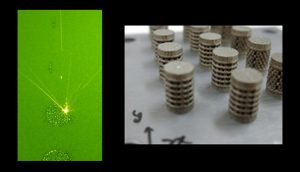Hard Tissue Biomechanics
硬組織のバイオメカニクス
Mechanical behavior of biomimetically mineralized collagen matrix using PILP process
骨マトリックスの階層構造・力学特性
Microscopically, bone is a composite structure consisting of inorganic mineral crystals and organic collagen molecules. In recent years, attempts have been made to develop artificial bone materials that mimic these microscopic composite structures. However, it has not been realized because the details are still unknown. Polymer-induced liquid precursor (PILP) process has attracted attention for the purpose of mineralization of such polymer matrix. According to this method, it is possible to easily generate calcified tissue derived from the polymer matrix structure, and it will contribute to the development of biomaterials that have a hierarchical structure similar to living bones and mechanical functions. In our laboratory, we are conducting research to clarify the relationship between structural and mechanical properties of mineralized bone-like materials fabricated by the PILP process.
微視的には骨は無機成分のミネラル結晶と有機成分のコラーゲン分子からなる複合構造です.近年,これらの微視複合構造を模倣した人工骨材料の開発も試みられてはいますが,コラーゲンの力学的役割、特にアパタイトとの力学的相互作用については複雑かつ微細であり,可視化等による解明も困難であり,その詳細が未だ不明のため,実現には至っていません.このような高分子マトリックスの石灰化を目的として,高分子誘導液体前駆体(PILP)プロセスが注目されています.本手法によれば,高分子マトリックス構造に由来した石灰化組織を簡便に生成することが可能となり,より生体骨に近い階層構造性を持ち,力学的機能を併せ持つバイオマテリアル開発に寄与するものと考えられます.本研究室では、PILPプロセスにより作製した石灰化骨様マテリアルについて,その構造特性と力学的特性の関係について明らかにする研究を行っています.
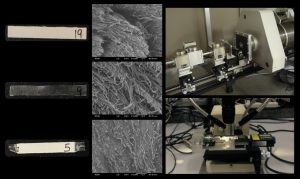
Cancellous stiffness with the microarchitecture of the trabecular network
海綿骨骨梁構造と強度特性
In osteoporosis, there are many fractures in areas where cancellous bone occupies a large proportion. Cancellous bone has a structure in which small beam-like bones called trabeculae are arranged in a three-dimensional structure. The strength of cancellous bone as a whole is less than one-tenth that of cortical bone and is known to depend on the trabecular structure. The relationship between the structural and mechanical properties have not yet been clarified. In this laboratory, we are researching the measurement method of mechanical properties from cancellous bone to trabecular level and the relationship between trabecular network structure and mechanical properties.
骨粗鬆症では,主に海綿骨が多く占める部位での骨折が多く見られます.海綿骨は,骨梁と呼ばれる小さな梁状の骨が3次元編目状に配列した構造です.海綿骨全体の強度は皮質骨の十分の一以下であり,骨梁構造に依存することが知られていますが,一つひとつの骨梁は長さが1mm程度と非常に小さいため骨梁単体の力学的特性は未だ明らかにされていません.本研究室では,海綿骨から骨梁レベルの力学的特性の計測方法や,骨梁ネットワーク構造と力学的特性の関係について研究しています.
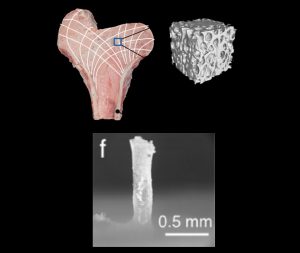
Skeletal Biomechanics
骨格系のバイオメカニクス
Friction properties of synovial joints
生体関節の摩擦特性評価
Biological synovial joints have excellent mechanical functions such as load transmission and lubrication. Therefore, early detection of degeneration and development of conservative treatment methods are important. In our laboratory, as one of the joint function evaluation methods, we have developed a pendulum type joint friction measuring device and are quantitatively evaluating the effects of osteoarthritis on joint friction characteristics and the effects of pharmaceutical treatment.
生体関節は,荷重の伝達と潤滑という優れた力学的機能をもつ一方,乏血行性により自然修復がほとんど期待できず,損傷を受けた場合,徐々に変性が進行し,変形性関節症などの症状になる危険性を有しています.そのため変性の早期特定と保存的治療法の開発が重要となっています.本研究室では,関節機能評価法の一つとして,振り子式関節摩擦測定機を作製し変形性関節症による関節摩擦特性への影響や,薬剤投与による効果の定量的評価を行っています.
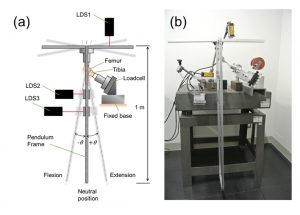
Motion analysis by wearable motion capture systems
モーションキャプチャによる人体運動解析
Currently, various lower extremity motor dysfunctions such as osteoarthritis and rheumatoid arthritis, which are often seen in the elderly, are becoming a problem. Human motion analysis, including gait analysis, is used to prevent such joint disorders and to monitor treatment progress. In recent years, wearable motion capture systems using inertial sensors have been developed. In our laboratory, we are developing a method for estimating the joint load from the body segment acceleration information obtained from the accelerometer attached to the human body based on the motion model of the human body.
現在,高齢者に多く見られる変形性関節症や,関節リウマチのような様々な下肢運動機能障害が問題となっています.このような関節障害の予防や治療経過の観察などに歩行解析をはじめとした人体の運動解析が役立てられており,近年は,慣性センサを用いたウェアラブルなモーションキャプチャシステムが開発されている.本研究室では,人体の運動モデルに基づき,装着した加速度センサから得られた体節加速度情報から関節負荷を推定する手法の開発を行っています.
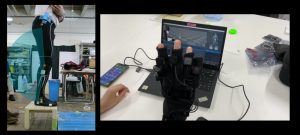
Biomaterials
バイオマテリアル
Porous implants by additive manufacturing
付加製造法による多孔質インプラント作製
Additive manufacturing is a new technology that has many advantages over conventional manufacturing technologies, such as weight reduction and high strength. In the medical field, application to the development of implants based on this technology is expected, and further improvements in performance and reliability are required. In our laboratory, we are conducting additive manufacturing experiments with a metal 3D printer and investigating the relationship between structural parameters and mechanical properties by mechanical tests of the fabricated metal lattice structure.
付加製造(積層造形)は新たな技術として,従来の製造技術よりも優れた特性として,軽量化や高強度など多くの利点を有しています.医学の分野でも,この技術に基づくインプラント開発への応用が期待されており,さらなる性能の向上や信頼性の向上が求められています.当研究室では,金属3Dプリンタによる積層造形実験を行い,作製した金属格子構造の力学試験により構造パラメータと力学特性との関係について調査を行っています.
